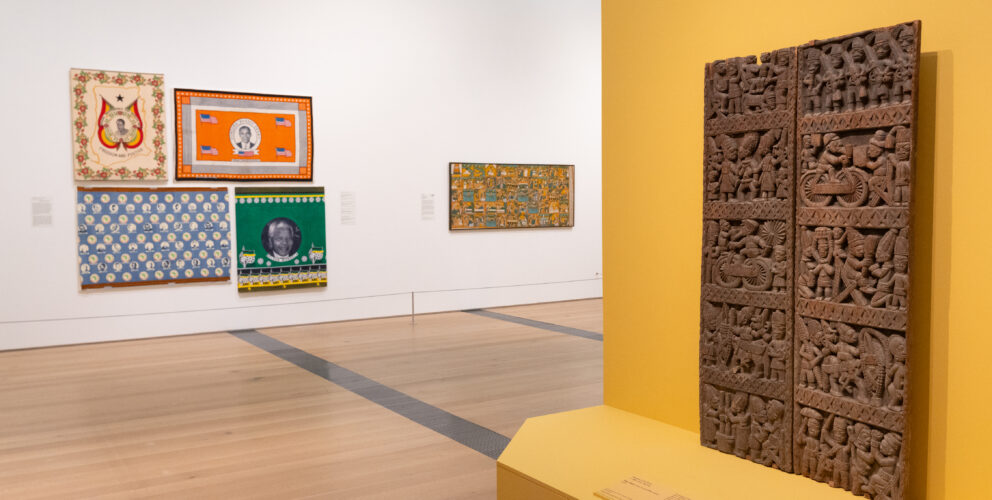Rift Valley Textiles (Rivatex), Kenya, 1975–2000; Khanga (Pears), 1970s; cotton; 43 x 120 inches; Saint Louis Art Museum, Gift of an anonymous donor 55:2024
Many women, members of the LGBTQIA+ community, and other marginalized people in eastern Africa have utilized khangas to give voice to notions which cannot be spoken aloud. Changing with the social climate of the region, the role of these textiles has transformed from communicating one’s societal status to communicating a sense of one’s cultural identity.
Designed and sold in pairs, khangas are rectangular textiles that can be worn as skirts, headwraps, baby carriers, and more, often with the matched set worn together. Typically, their designs consist of a central motif and a line of text, both bordered by a repeating pattern. For example, the work shown below presents two pears as its central motif, with a border of stylized leaves. The phrase wafinyanzi hupikia vigae (roughly: The potter makes tiles) sits below the pears. Most khangas feature these three design details, but potential for variation is unlimited.

Rift Valley Textiles (Rivatex), Kenya, 1975–2000; Khanga (Pears), 1970s; cotton; 43 x 120 inches; Saint Louis Art Museum, Gift of an anonymous donor 55:2024
Khangas came to prominence in the Swahili Coast, a region from Somalia south to Mozambique. In the 19th century, formerly enslaved women would wear khangas to demonstrate their status as free members of society. During the 20th century, the textiles were broadly used as gifts to celebrate life. At the time, Swahili was emerging as an identity, and the khanga became its marker, with its vibrant colors and quippy and historically significant messages. It was gifted often and worn by everyone, regardless of status. They are still worn and gifted today.
While the textile is a prominent fashion statement, khangas also act as a tool for subversive communication. The cloth can carefully convey what the wearer will not or cannot say aloud. “Shielded by the ambiguity of a short, poetic verse, women can subvert patriarchal norms and present their own perspectives, especially regarding matters of love and sex—not commonplace in a conservative, Muslim society,” Elyse Schaeffer wrote in the Narrative Wisdom and African Arts catalogue. Schaeffer is SLAM’s former research assistant for the department of the arts of Africa, Oceania, and the Americas.
Pictured on the aforementioned Khanga (Pears: Wafinyanzi Hupikia Vigae), the text possibly alludes to two Swahili proverbs: Mfinyanzi hupika kwa vigae (The potter cooks in a broken pot) and Mfinyanzi hulia gaeni (A potter eats from a potsherd). It is possible that the khanga text implies a bride-to-be rebuffing accusations of promiscuity. The ambiguity of the phrase both “shields and empowers the wearer or gift giver to voice opinions on otherwise private matters,” according to Schaeffer.

Kawira Mwirichia, Kenyan, 1986–2020; printed by Haria's Stamp Shop Limited, Nairobi, Kenya, founded 1958; To Revolutionary Type Love: Brazil (Mziki Wangu Maisha, Nawe Viatu Vya Kusakata Rhumba), designed 2017, printed 2023; digital print on polyester; 37 1/2 x 58 inches; Saint Louis Art Museum, Museum purchase 56:2024; © Estate of Kawira Mwirichia
Artist Kawira Mwirichia expanded the khanga’s history of speaking out against oppression by adopting the khanga format to advocate for LGBTQIA+ people worldwide. In the central panel of the printed khanga cloth, shown above, layered “thumbs-up” outlines form black-and-white semicircles against the green background. Full-circle versions of the hand line the cloth’s purple border. The thumbs-up design was sourced from the logo for Brazil’s São Paulo Pride Parade Association (Associação da Parada do Orgulho LGBT+ de São Paulo), which has organized that city’s annual Pride parade since 1999. This khanga is one in a series titled To Revolutionary Type Love, in which each khanga represents a different country.
Instead of proverbs, Mwirichia includes quotes from global queer history. In To Revolutionary Type Love: Brazil, Mwirichia features the quote, “Mziki wangu maisha, nawe viatu vya kusakata rhumba,” which translates to “music is my life and you’re my dancing shoes.”
To Revolutionary Type Love: Brazil is on view in Narrative Wisdom and African Arts through February 16 at SLAM. Images from the entire To Revolutionary Type Love series are viewable on an interactive screen in the final gallery of the exhibition.
This information was adapted from Elyse D. Schaeffer’s essay, “Love: Let Me Count the Ways,” which appears in the exhibition catalogue Narrative Wisdom and African Arts. The catalogue considers ways in which historical and contemporary African arts make visible narratives rooted in collective and individual memory and knowledge. It is available for purchase online and in Museum shops.
